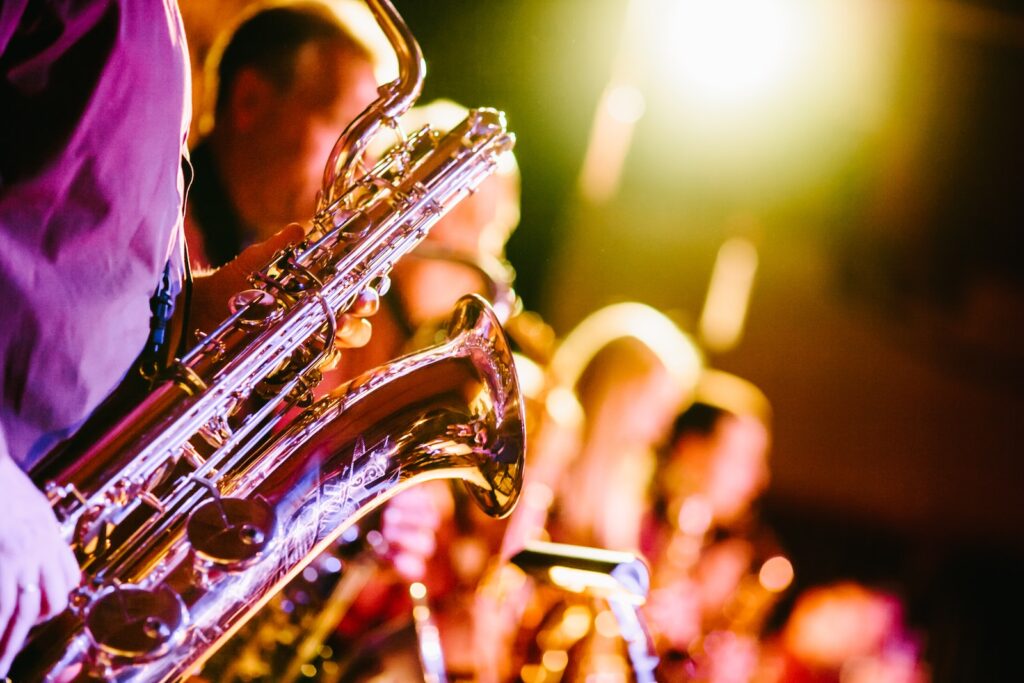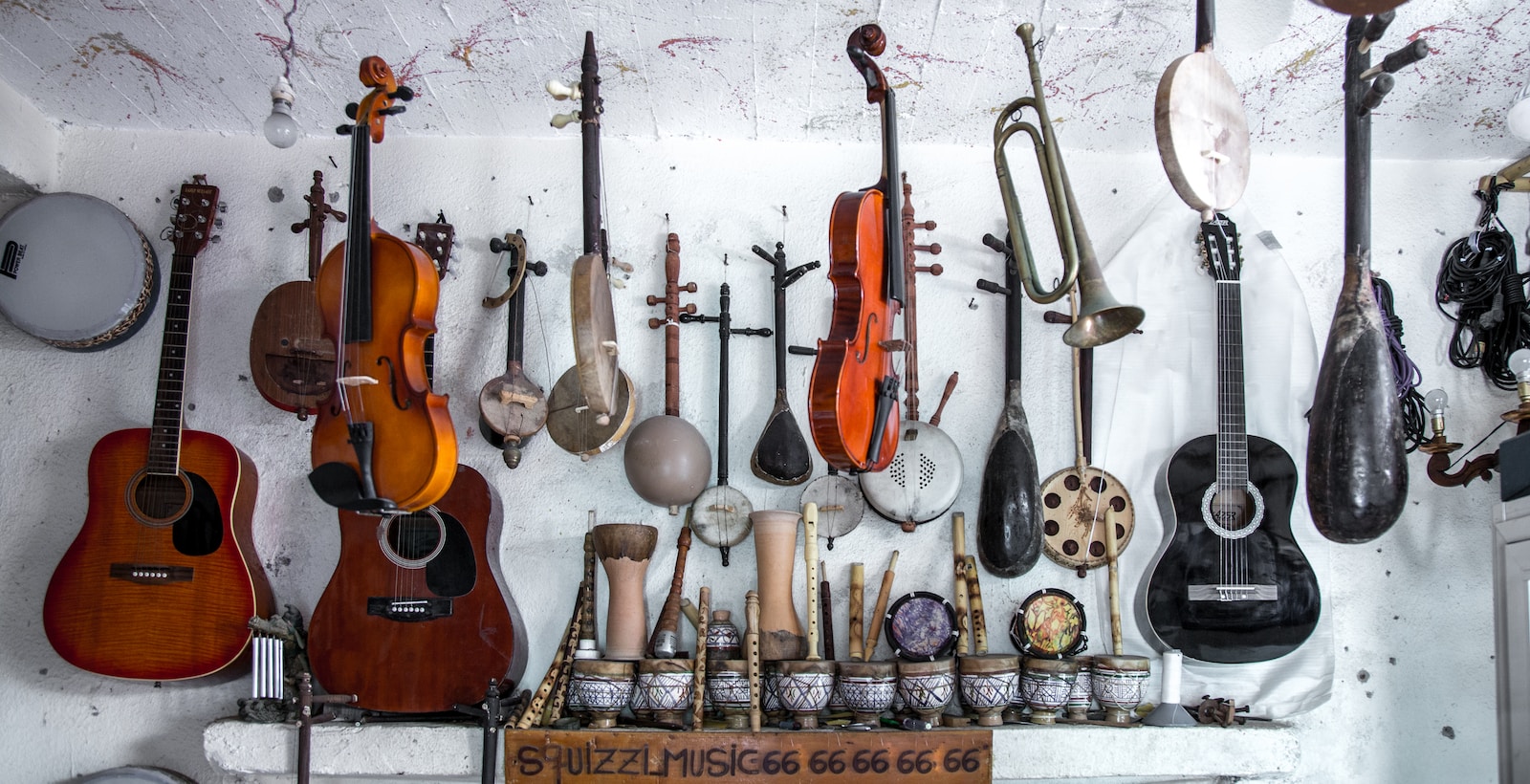Welcome, music enthusiasts! Today, we’re taking a tuneful trip down memory lane to explore the fascinating history of music band instruments. From the primal beats of ancient drums to the electrifying guitar solos of rock legends, the evolution of sound has been a remarkable journey. So, let’s dive in and uncover the story behind the instruments that have made music bands groove and groove throughout the ages.
The Evolution of Sound: A Brief History of Music Band Instruments

Ancient Beginnings: Drums and Percussion
Our musical voyage begins in the distant past, where early humans discovered the primal joy of pounding on drums and percussion instruments. These rhythmic wonders were the heartbeat of tribal gatherings, adding a dose of groove to rituals and celebrations.
In ancient Mesopotamia, around 2000 BCE, the earliest known form of the drum called the “tympanum” was discovered. It was a simple frame drum with stretched animal skin, and it’s safe to say that it laid the foundation for countless percussion instruments that followed.
Medieval Marvels: Strings Take the Stage
Fast forward to the medieval era, where strings started to steal the limelight. The emergence of instruments like the lute, harp, and lyre brought a new dimension to music. These stringed beauties were plucked, strummed, and bowed to create enchanting melodies.
One standout star of this era was the lute, a pear-shaped instrument with strings that were plucked by the fingers. Its sweet, melodic tones could transport listeners to far-off lands, making it a favorite in courts and taverns alike.
The Renaissance Revolution: Woodwinds and Brass Emerge
As we venture into the Renaissance period, we encounter a burst of creativity in the world of music band instruments. Woodwinds like the flute and recorder, along with brass instruments such as the trumpet and trombone, began to make their mark.
The recorder, with its delicate notes, found favor in the courts of Europe, while the trumpet’s triumphant blare added regal splendor to royal ceremonies. These instruments played a pivotal role in shaping the music of the time, leaving a lasting legacy.
The Birth of Modernity: Enter the Brass Band
With the dawn of the Industrial Revolution in the 18th century, music bands started to take on a more organized form. Brass bands became a sensation, with their bold and brassy sounds echoing through streets and concert halls.
The invention of valves in brass instruments revolutionized their playability, allowing for more complex compositions and dynamic performances. Suddenly, the brass band became the life of the party, captivating audiences with their rousing tunes.
Rock ‘n’ Roll and Electric Dreams
Fast forward to the 20th century, and we’re in the midst of a musical revolution. The electric guitar, born out of innovation and the desire for amplified sound, became the emblem of rock ‘n’ roll. Musicians like Jimi Hendrix and Eric Clapton wielded their electric guitars like magic wands, conjuring unforgettable riffs and solos.
Electric keyboards and synthesizers also joined the bandwagon, adding futuristic sounds and endless possibilities to music. Bands like Pink Floyd and Kraftwerk embraced these electronic marvels, pushing the boundaries of sonic exploration.
Today and Beyond: A Symphony of Possibilities
In the 21st century, music band instruments continue to evolve. From digital synthesizers to virtual instruments, technology has opened up a world of sonic experimentation. Musicians can now create entire orchestras with a single keyboard and explore genres that were once unimaginable.
As we look ahead, it’s clear that the history of music band instruments is an ever-unfolding tale of innovation and creativity. Each instrument, from the humble drum to the futuristic synthesizer, contributes its unique voice to the symphony of sound that defines our musical journey.
The Essential Toolkit: Must-Have Instruments for Any Live Band

Hey there, music enthusiasts and aspiring rockstars! If you’ve ever dreamt of starting a live band or you’re already jamming with your buddies, you know that having the right instruments is like having the perfect recipe for a musical masterpiece. In this blog post, we’re going to dive into the essential toolkit that every live band should have. So, grab your air guitar and let’s rock on!
1. The Almighty Guitar 🎸
Ah, the electric guitar, the heart and soul of any rock ‘n’ roll band. Whether it’s shredding epic solos or strumming soulful chords, this six-string wonder is a must-have. From the classic Fender Stratocaster to the Gibson Les Paul, there’s a guitar out there for every style and budget. Just remember, when you’re on stage, you’re not just playing notes; you’re playing the crowd!
2. The Thunderous Bass 🎶
Meet the unsung hero of the band—the bass guitar. It might not always be in the limelight, but it’s the backbone that keeps the rhythm going. That deep, thumping sound you feel in your chest at a live concert? That’s the bass, my friends. From the sleek Precision Bass to the versatile Jazz Bass, choose one that grooves with your band’s vibe.
3. The Beat Machine: Drums 🥁
What’s a live band without a drummer who can bring the rhythm to life? Drums are the heartbeat of your music, and you’ll need a good drum kit to get heads nodding and feet tapping. Explore acoustic drum kits or opt for electronic drums for a modern twist. Don’t forget to practice your drum faces for the full experience!
4. The Versatile Keyboards 🎹
Keyboards are like the Swiss Army knives of the band, offering a wide range of sounds and effects. Whether it’s classic piano melodies, funky organ grooves, or synth-driven electronica, keyboards can add depth and dimension to your music. A quality keyboard is a versatile addition to any live band setup.
5. The Harmonious Vocals 🎤
Last but not least, your voice is your most powerful instrument. Whether you’re the lead singer or harmonizing with the band, vocals are what connect with your audience on a personal level. Invest in a good microphone, hone your vocal skills, and let your voice soar. Remember, it’s not just what you sing; it’s how you sing it!
6. The Magical Accessories ✨
Beyond the core instruments, there are some handy accessories every live band should have in their toolkit. These include guitar pedals for creating mind-bending effects, drum sticks and cymbals for the drummer’s arsenal, and a reliable amplifier to make your instruments sing louder and prouder.
7. The Golden Rule: Practice Makes Perfect 🌟
Now that you’ve got your essential toolkit, here’s the most crucial instrument of all—dedication. Practice, practice, and practice some more. A live band is only as good as its musicians, and the more you rehearse, the tighter your sound will become. So, grab your instruments, hit that rehearsal space, and turn those musical dreams into reality!
Mastering Your Craft: Tips for Perfecting Your Instrument Skills

Are you ready to take your music band instrument skills to the next level? Well, you’re in the right place! In this section, we’ll dive into some fun and effective tips to help you become a true maestro with your chosen instrument. Whether you’re a guitarist, drummer, or keyboardist, we’ve got you covered. Let’s get those fingers and hands moving to the rhythm of success!
1. Consistency is Your Best Friend
Consistency is the name of the game when it comes to mastering any musical instrument. Make practicing a daily habit, even if it’s just for 15-30 minutes. Regularity will help your muscle memory develop, making it easier to nail those tricky chords or rhythms when you’re performing live with your band.
2. Break It Down, Baby!
Learning a complex piece of music can be overwhelming. Break it down into smaller, manageable sections. Tackle one part at a time until you’ve got it down pat. Then, move on to the next section. This method not only makes learning more manageable but also gives you a sense of accomplishment as you conquer each piece.
3. Embrace the Metronome
Ah, the metronome! It’s not just a ticking annoyance; it’s your best friend for mastering rhythm. Use it to keep your timing in check. Start slow and gradually increase the tempo as you become more comfortable. You’ll be amazed at how your precision improves.
4. Play Along with Your Favorite Songs
Learning doesn’t have to be all scales and exercises. Pick some of your favorite songs and try to play along with them. It’s not only a blast but also an excellent way to improve your sense of timing, dynamics, and style. Plus, it makes practice feel less like work and more like play.
5. Learn from the Pros
Don’t hesitate to take lessons or seek guidance from more experienced musicians. Whether it’s a fellow band member or a seasoned teacher, learning from others can provide valuable insights and shortcuts to success. They’ve been where you are now and can share their wisdom to help you improve.
6. Record Yourself
Ever cringe when you hear your own voice on a recording? Well, recording yourself playing your instrument can have a similar effect. But it’s an incredibly valuable tool for self-improvement. It allows you to spot areas that need work, identify mistakes, and track your progress over time.
7. Experiment with Different Styles
While it’s essential to focus on the style of music your band plays, don’t be afraid to experiment with other genres. Playing jazz if you’re in a rock band or trying out some blues if you’re a classically trained pianist can broaden your horizons and bring fresh ideas to your band’s sound.
8. Stay Inspired
Passion and inspiration are the driving forces behind any great musician. Listen to diverse music, attend live performances, and immerse yourself in the world of music to stay motivated. The more you feed your musical soul, the more creativity you’ll bring to your band.
9. Set Realistic Goals
Dreaming big is fantastic, but it’s equally important to set achievable short-term goals. Maybe it’s mastering a particular solo, learning a new technique, or composing your own music. Small victories along the way will keep you motivated and on track.
10. Don’t Fear Mistakes
Last but not least, embrace mistakes. They are an inevitable part of the learning process. Instead of getting discouraged, use them as opportunities to learn and grow. Remember, even the greatest musicians in the world were once beginners who made plenty of mistakes along the way.
The Power of Harmony: How Different Instruments Create a Magical Live Experience

1: The Symphony of Sound
Imagine this: you’re at a live music concert, the stage bathed in vibrant lights, and the crowd buzzing with anticipation. Suddenly, the first notes ring out, and you’re transported to a world of musical wonder. What makes this experience truly magical is the power of harmony, where different instruments come together to create a symphony of sound that captivates the soul.
In a music band, each instrument has its unique role to play, just like characters in a story. The bass guitar lays down the foundation, the drums provide the heartbeat, and the keyboards add depth and texture. It’s a harmonious collaboration that forms the backbone of any live performance.
2: The Dance of Diversity
One of the remarkable aspects of live music bands is the sheer diversity of instruments they bring to the stage. From the twang of an electric guitar to the soulful wail of a saxophone, every instrument has its own voice and personality. It’s like a musical potluck, where each dish (or instrument) brings its own flavor to the party.
Consider a rock band, for instance. The electric guitar might take center stage with its fiery solos, while the drums keep the rhythm steady. Add in some keyboard melodies, and you’ve got a harmonious blend of high-energy rock. The synergy of these different instruments creates a sonic landscape that’s nothing short of magical.
3: The Alchemy of Fusion
Now, let’s talk about fusion. No, not the science-y kind, but the musical fusion that occurs when instruments from different genres come together. Think of a jazz band infusing a bit of blues, or a folk band incorporating elements of rock. It’s like mixing colors on a palette to create a new and mesmerizing hue.
In the world of live music, fusion is where the real magic happens. When musicians experiment with blending instruments from various genres, they open up a world of possibilities. The result? A live performance that defies boundaries and takes the audience on a journey through uncharted musical territories.
4: The Art of Balance
Harmony in a music band isn’t just about playing instruments together; it’s also about striking the right balance. Each instrument has its moment in the spotlight, and knowing when to step forward or step back is an art form in itself. It’s like a perfectly choreographed dance where every move is synchronized.
Take a symphony orchestra, for example. The conductor skillfully guides the musicians, ensuring that the strings, woodwinds, brass, and percussion harmonize seamlessly. It’s a delicate interplay of dynamics, with crescendos that raise the hairs on your arms and pianissimos that make you hold your breath.
In a live band, finding that sweet spot where every instrument shines without overpowering the others is the key to creating a magical experience for the audience. It’s a testament to the skill and chemistry of the musicians.
In conclusion, the power of harmony in live music bands is akin to witnessing a spectacular fireworks display in the night sky. It’s a dazzling array of colors and sounds that come together to create a breathtaking experience. So, the next time you attend a live music concert, close your eyes, listen closely, and let the magic of harmony transport you to a world of musical enchantment where different instruments unite to create something truly extraordinary.

